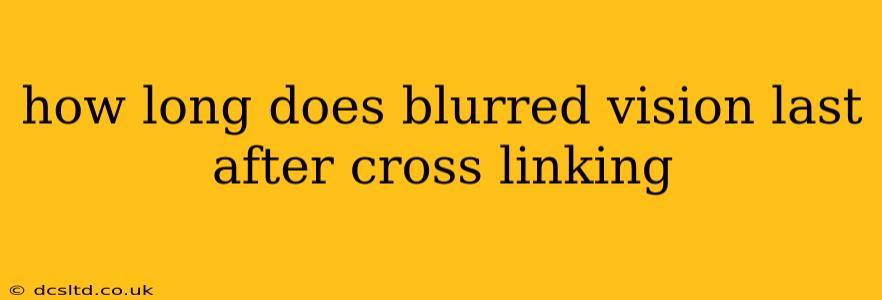Corneal cross-linking (CXL) is a procedure used to strengthen the cornea and slow or halt the progression of keratoconus, a condition causing the cornea to thin and bulge, resulting in blurred vision. While CXL is highly effective, it's important to understand the recovery process, including the duration of blurred vision. The length of time blurred vision persists varies greatly from person to person, but let's explore the typical timeline and factors influencing it.
What is Corneal Cross-Linking?
Before diving into recovery times, let's briefly revisit what CXL entails. The procedure involves using riboflavin (vitamin B2) eye drops and ultraviolet (UV-A) light to create chemical bonds within the collagen fibers of the cornea, making it more rigid and resistant to further deformation. This helps stabilize the shape of the cornea and improve visual acuity.
How Long Does Blurred Vision Typically Last?
The immediate post-operative period often involves significant blurry vision. This is a normal part of the healing process. Generally, you can expect some level of blurred vision for several days to a few weeks. However, significant improvement usually begins within the first week, with many patients noticing a marked reduction in blurriness within one to two weeks. Complete recovery and optimal visual acuity may take several months.
What Factors Influence Recovery Time?
Several factors can influence how long blurred vision lasts after CXL:
-
Severity of Keratoconus: Patients with more severe keratoconus may experience longer recovery times and more persistent blurred vision. The more significant the corneal distortion before the procedure, the longer it takes to stabilize and for vision to improve.
-
Type of CXL Procedure: Different CXL techniques exist, and the specifics of the procedure might influence the recovery timeline. Discussions with your ophthalmologist regarding the specific procedure used are crucial for understanding expected outcomes.
-
Individual Healing Rate: Just as with any surgical procedure, individual healing rates vary. Some individuals heal faster than others, impacting the duration of blurred vision and overall recovery.
-
Post-operative Care: Following your ophthalmologist's post-operative instructions diligently is crucial for optimal healing and minimizing complications. This includes using prescribed eye drops and attending all follow-up appointments.
What Can I Expect During Recovery?
During recovery, you might experience:
- Blurred Vision: This is the most common side effect, usually improving gradually.
- Discomfort: Some mild discomfort or irritation is expected, usually managed with prescribed eye drops.
- Light Sensitivity: You might be more sensitive to light initially. Sunglasses are recommended.
- Halos: Some patients may experience halos around lights, particularly at night.
When Should I Contact My Doctor?
While some blurred vision is normal, it's essential to contact your ophthalmologist if you experience:
- Severe or persistent pain
- Increased redness or swelling
- Decreased vision or sudden vision loss
- Any signs of infection
Is the Blurred Vision Permanent?
The blurred vision is not typically permanent. The goal of CXL is to stabilize the cornea and improve vision, and for the vast majority of patients, the blurred vision is temporary. However, the degree of improvement varies based on the individual and the severity of their keratoconus.
What are the Long-Term Outcomes of CXL?
CXL is a highly effective treatment for keratoconus, helping to prevent further progression of the disease and improve visual acuity. While some individuals may still require additional vision correction after CXL, such as glasses or contact lenses, many experience a significant improvement in their vision.
In conclusion, while blurred vision is a common side effect after CXL, it's typically temporary. The duration varies, but significant improvement usually occurs within weeks, with complete recovery taking several months. Close follow-up with your ophthalmologist is crucial for monitoring your progress and addressing any concerns. Remember, individual results may vary.
